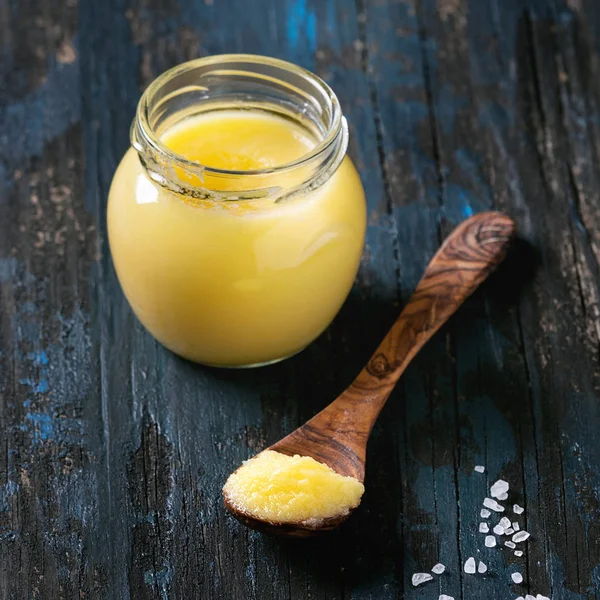Description
The term “desi” refers to something native or local to the Indian subcontinent. Unlike commercially produced ghee, which may involve industrial methods, desi ghee is made using traditional techniques, often from cow’s milk, giving it a distinct taste, texture, and aroma that is cherished in South Asian cuisine.
How is Desi Ghee Made?
Desi ghee is made through a multi-step process, typically starting with the production of curd (yogurt) from milk. Here’s a simple way to make it at home:
Desi Ghee Recipe:
Ingredients:
- 2-3 liters of whole milk (preferably from grass-fed cows)
- 1-2 tablespoons of yogurt (to make curd)
- A heavy-bottomed pan or wok
Method:
- Making Curd (Dahi):
- Heat the milk in a large saucepan until it comes to a boil. Allow it to cool to a lukewarm temperature (around 40–45°C or 104–113°F).
- Add a tablespoon of yogurt to the milk and mix well. Cover the container and let it sit in a warm place for about 6–8 hours (or overnight) to set the curd. The curd should be thick and creamy.
- Churning the Curd to Make Butter:
- Once the curd has set, take a portion of it (around 1-2 cups) and place it in a deep mixing bowl.
- Add cool water and churn the curd using a traditional matka (clay pot and stick) or an electric blender until the butter separates from the buttermilk. This process is called bilona method and is the traditional way of churning curd into butter.
- Cooking the Butter (Clarifying):
- Take the separated butter and transfer it into a heavy-bottomed pan or wok.
- On medium heat, start heating the butter slowly. As the butter melts, the milk solids will begin to settle at the bottom, and the water content will evaporate.
- Keep stirring occasionally and allow the butter to cook for 10-15 minutes. As it simmers, the ghee will turn golden and release a nutty aroma. The milk solids will brown and settle at the bottom of the pan.
- Once the ghee becomes clear and no longer has any bubbling or foaming, it’s ready.
- Strain the liquid ghee using a fine mesh strainer or cheesecloth into a clean glass jar, discarding the milk solids.
- Storing Ghee:
- Let the ghee cool to room temperature and store it in an airtight container. Desi ghee can last for several months at room temperature or even longer when refrigerated.
Health Benefits of Desi Ghee
Desi ghee has been valued for centuries due to its numerous health benefits, many of which are supported by modern science. Here’s why desi ghee is considered a superfood:
- Rich in Healthy Fats:
- Ghee is rich in saturated fats, particularly short-chain and medium-chain fatty acids like butyrate. These fats are easily absorbed by the body and are essential for maintaining healthy cells, hormone production, and overall energy levels.
- The fat in ghee helps improve the absorption of fat-soluble vitamins (A, D, E, and K) from other foods.
- Improves Digestion:
- Desi ghee is known for its digestive benefits. It contains butyrate, a short-chain fatty acid that has been shown to support gut health, improve digestion, and reduce inflammation in the intestines. This makes ghee beneficial for those with digestive issues like irritable bowel syndrome (IBS) or constipation.
- It also has a soothing effect on the digestive tract, promoting the healthy secretion of gastric juices and helping to heal the gut lining.
- Boosts Immunity:
- Ghee contains antioxidants, including vitamin E and omega-3 fatty acids, which help reduce oxidative stress and bolster the immune system.
- Ghee’s antimicrobial properties also help fight off infections and boost the body’s defense mechanisms.
- Promotes Skin Health:
- The fatty acids in ghee help nourish and moisturize the skin from within. It is often used in Ayurvedic treatments for promoting healthy, glowing skin and reducing dryness or irritation.
- The vitamin A in ghee is also beneficial for skin regeneration and can help in reducing signs of aging.
- Enhances Brain Function:
- Ghee’s high content of omega-3 fatty acids, particularly DHA (docosahexaenoic acid), makes it great for brain health. DHA is a crucial component of brain cell membranes and is known to enhance memory, cognition, and overall brain function.
- Consuming ghee regularly can help support cognitive function and reduce the risk of neurological diseases like Alzheimer’s.
- Anti-inflammatory Properties:
- Desi ghee has natural anti-inflammatory properties, particularly due to the presence of butyrate. This helps to reduce inflammation throughout the body, which can benefit those with chronic inflammatory conditions like arthritis.
- Supports Weight Loss:
- While ghee is calorie-dense, the healthy fats it contains help in increasing metabolic rate and can aid in fat burning when consumed in moderation. It also supports the production of bile, which aids in fat digestion.
- Ghee can be a part of a balanced diet for weight management if used in controlled amounts.
Drawbacks of Desi Ghee
While desi ghee has numerous health benefits, there are some potential drawbacks that need to be considered, especially if consumed in excess.
- High in Calories:
- Ghee is calorie-dense, with approximately 120-130 calories per tablespoon. Overconsumption can lead to excess calorie intake, which may contribute to weight gain if not balanced with physical activity.
- Those with weight management issues should monitor their intake of ghee to avoid unnecessary calorie surplus.
- Saturated Fat Content:
- Ghee contains a significant amount of saturated fat, which has been historically linked to an increased risk of heart disease when consumed in excess. However, recent research suggests that the type of saturated fats found in ghee (such as butyrate) may not have the same negative effects on heart health as other forms of saturated fat.
- For individuals with high cholesterol or a history of heart disease, it’s recommended to consult a healthcare provider before regularly consuming ghee.
- Lactose Sensitivity:
- While ghee is clarified and contains minimal lactose, individuals who are highly sensitive to dairy may still experience reactions, such as bloating or discomfort. Ghee is generally considered safe for people with lactose intolerance, but those with severe dairy allergies should avoid it.
- Cost and Authenticity:
- High-quality, authentic desi ghee (made traditionally from grass-fed cow’s milk) can be expensive. Commercially produced ghee may not offer the same nutritional benefits and may contain additives or preservatives.
- To ensure the best health benefits, it’s essential to use pure, organic ghee made from traditional methods.
- Not Suitable for High-Heat Cooking (If Not Pure Ghee):
- While ghee is generally stable at high cooking temperatures due to its low moisture content, cheap or adulterated ghee may burn or degrade at high heat, potentially releasing harmful compounds. Always use high-quality, pure desi ghee for cooking.
Final Thoughts on Desi Ghee
Desi ghee is a nutrient-rich, versatile, and health-boosting food that has been a part of traditional diets for centuries. Whether used in cooking, baking, or as part of wellness rituals, its numerous health benefits—ranging from improving digestion and boosting immunity to supporting brain function and skin health—make it a valuable addition to your diet. However, it is essential to consume ghee in moderation to avoid excess calorie intake and maintain a balanced, healthy lifestyle. As with any food, it’s important to use high-quality, traditional desi ghee to ensure you’re reaping its full benefits.
When used appropriately, ghee can be a powerful ally in maintaining overall health and wellness.


Reviews
There are no reviews yet.